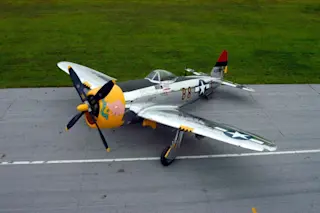Republic P-47D at the National Museum of the United States Air Force. Credit: U.S. Air Force Toward the end of the 1998 film "Saving Private Ryan," American soldiers played by actors Matt Damon and Tom Hanks witness U.S. fighter aircraft swooping to their rescue. "They're P-51s, sir, tank busters!" Damon exclaims. In reality, the fighter aircraft swooping to the rescue of embattled U.S. infantrymen would more likely have been the P-47 Thunderbolt, a stocky aircraft with the unflattering nickname of the "flying jug." During the aircraft's 75th anniversary, it's worth remembering how the P-47 came to symbolize U.S. airpower's contribution to victory in World War II. The U.S. Army Air Force introduced the Republic P-47 Thunderbolt to protect U.S. bombers flying deep into enemy territory over occupied Europe. By the end of World War II, the P-47 had helped the Allies win air superiority over Europe by driving German fighters ...
How a 'Flying Jug' Symbolized US Airpower in WWII
The P-47 Thunderbolt represents a key U.S. fighter aircraft that helped achieve air superiority over Europe in WWII.
More on Discover
Stay Curious
SubscribeTo The Magazine
Save up to 40% off the cover price when you subscribe to Discover magazine.
Subscribe













